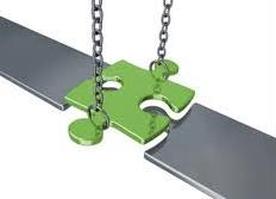| Succession Planning, or Transition Planning, can be simply defined as the orderly process of transferring responsibility, management and ownership from one generation to the next. Our experience working with business-owning families reveals that the order in which each of these separate transfers take place is a crucial element in a successful transition. Attempting to do things in the wrong order, or even accidentally doing things in the wrong order, usually results in disruption and spoiled family and business relationships. |
|
A small list of things that will negatively impact your family business transition are as follows. If you see a few of these in your family business, consider developing a more systematic plan for the generational transfer of your family farm business:
0 Comments
 Nope. Policies Continued. Nope. Policies Continued. Can you believe this guy? Ummm. Yeah. Me Neither! Last week we began explore another area of your family farm business management system as you begin the succession planning process and plan for a successful generational transfer of responsibility, management and ownership of your family business. So, let's explore the need for policies a little deeper.
Job descriptions serve many functions and if this is new information for you…great! If you’ve heard it before and never really implemented anything…well, shame on you. Just kidding. Seriously, this is all about continuous improvement. So, back to job descriptions. In our practice, the unofficial statistics reveal that less than half of our most modern agricultural producers have adopted this as part of their management practices. How can this be? After working with many family farm clients in this area we learned that a common roadblock was that they did not completely understand the need for job descriptions or how to go about implementing the idea. Secondarily, we have also heard feedback that formalized job descriptions were more for non-family business employees and staff. Let’s examine further…shall we? Job descriptions help in daily operations as well as succession planning in a few key ways.
So, the need for job descriptions for your family farm have been clearly stated. Now what? A seemingly difficult, but fairly simple task is to begin by documenting the various tasks and decision-making areas of your family business. There are now two key tasks to perform and listed in the order of importance below…
 You need a process for filling the gaps between the skills possessed by your team and the skills needed for the future. You need a process for filling the gaps between the skills possessed by your team and the skills needed for the future. Oftentimes, the least qualified person on the team is doing something they shouldn’t be, or is tasked with something that they really don’t have the skills to perform. This happens for many different reasons. By determining the qualifications and skills needed for the task ahead of time, it becomes less personal and more objective to assess who should perform what role in your family farm business. Regardless of a transition plan or not, this exercise might help rearrange your team members to perform different roles that they are more qualified to perform. You and your team might become more effective and happier. This exercise also helps show where gaps may exist. Oftentimes, no one is qualified to perform a certain task or area of decision making. So, it needs to be outsourced, filled internally or someone needs to get the training necessary to fill that role. As mentioned above, when looking toward the future and the “stepping aside” by senior management and the “stepping up” by a successor generation, presumably there are differences between the decision-making skills and areas of responsibility between the two generations, with the senior generation having much more responsibility and decision-making authority, along with the associated skills to do so. The gap between the roles each performs today and what you have determined needs to be performed in the future becomes your management transition plan. For example, Uncle Joe and Dad make any land purchase decisions. When Dad and Uncle Joe retire in 10 years, Billy and Susie are going to need to make those decisions. What skills do Dad and Uncle Joe possess today that enable them to make good land purchase decisions (presumably) that Billy and Susie will need to learn to make good decisions in the future? How are they going to learn them? Do they want to learn them? If not, who can they get to fill that role in the future? Does that make sense? Now, carry that line of thinking to all the roles and decision-making areas of the business. It’s just a matter of taking the time to determine the roles, gaps and timelines for gaining the necessary skills for continued success of your family business. To best accomplish this, honest self-assessments, performance reviews, natural strengths and weaknesses and a system for helping flush this all out builds the basis for continuity in operations and accomplishes a formidable task of any succession planning. As you might imagine, we have some various forms and detailed exercise to help you with this specific task. If you’d like a copy, please email me and we can get out to you right away. Until next time,
How Decisions Get Made and By Who Now is a good time to move into another phase of your management system that explores the concept of how your family business is organized…how decisions get made and by whom? There are multiple reasons why this is becoming increasingly more important in today’s modern agriculture. A bigger and more diversified operation with multiple entities is commonplace in today’s agricultural world. This is simply a matter of survival which requires growth to remain competitive. Certainly growth can come in many forms, but suffice it to say that the capital intensity and high-tech nature of modern agriculture demands more and more skills than in years past. As farms grow, more partners and owners work together. This increased complexity requires a more defined organizational structure.
Developing a process for improving your business planning including personal development plans for your team, standard operating procedures, setting policies and collecting, analyzing and responding to ever increasing record-keeping systems are a few additional areas to explore that will help further systematize your business in order to facilitate a management transition for your family business. Once management is transitioned, ownership transition is within reach. If you recall, the most successful transitions start with transferring responsibility, then management and eventually, ownership. We’ll begin with a short segment for today and continue with this next phase of discussions in subsequent posts. Transferring Responsibility - Delegation To keep things simple, there are only a few questions that must be answered:
It has already been established that today’s agriculture is too complex for one person to be technically skilled to handle all areas of the business. At the same time, making everyone responsible for everything is a fool’s theory. So, we must specialize and divide areas of responsibility. A common client question reasonably follows: “How do we structure things and keep everyone happy?” Well that’s the $64,000 question!
Next time -- a discussion about the need for job descriptions, performance reviews, guidelines for future leadership and how to come up with a plan to transition management. |
Categories
All
Archives
June 2020
Author
|






 RSS Feed
RSS Feed
